
Looking for Quince: How to can your own homemade quince - canned quince: complete, easy directions with photos in 2025? Scroll down this page and follow the links. And if you bring home some fruit or vegetables and want to can, freeze, make jam, salsa or pickles, see this page for simple, reliable, illustrated canning, freezing or preserving directions. There are plenty of other related resources, click on the resources dropdown above. If you are having a hard time finding canning lids, I've used these, and they're a great price & ship in 2 days.
If you have questions or feedback, please let me know! There are affiliate links on this page. Read our disclosure policy to learn more.
Quince: How to can your own homemade quince - canned quince: complete, easy directions with photos
How to Make Homemade Canned Quince
Click here for a PDF print version!
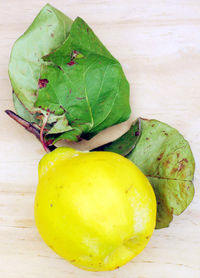 It's
easy to can your own quince! Here's how to do it, complete
instructions in easy steps and completely illustrated. In the
winter when you open a jar, the quince will taste MUCH better
than anything you've ever had from a store, and by selecting the
right fruit, it will use less sugar than store-bought canned
quince. Quince can be packed in very light, light or
medium sugar syrup. They can also be packed in water, apple
juice or white grape juice.
It's
easy to can your own quince! Here's how to do it, complete
instructions in easy steps and completely illustrated. In the
winter when you open a jar, the quince will taste MUCH better
than anything you've ever had from a store, and by selecting the
right fruit, it will use less sugar than store-bought canned
quince. Quince can be packed in very light, light or
medium sugar syrup. They can also be packed in water, apple
juice or white grape juice.
Prepared this way, the jars have a shelf life of about 12 to 18 months, and aside from storing in a cool, dark place, require no special attention.
You might also be interested in making quince butter; just use the pear butter recipe! Or Quince preserves / jam.
Directions for Making Canned Quince
Ingredients and Equipment
|
|
Recipe and Directions
Step 1 - Selecting the quince
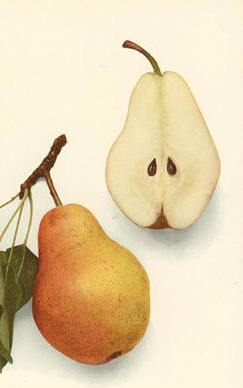 The
most important step! You need quince that are sweet, and ripe.
A little known fact: like pears, Quince are picked unripe - they don't
ripen well on the tree. So, unlike peaches, or apples quince WILL ripen at
home! Proper ripeness of quince at canning time is important to the
quality
The
most important step! You need quince that are sweet, and ripe.
A little known fact: like pears, Quince are picked unripe - they don't
ripen well on the tree. So, unlike peaches, or apples quince WILL ripen at
home! Proper ripeness of quince at canning time is important to the
quality
of the product; as it affects color, flavor, aroma, and
over-all quality of finished product
Choose ripe, mature fruit of ideal quality for eating fresh or cooking. They should not be mushy, but they also should not be rock hard: just as ripe as you would eat them fresh. If they are to be transported or not processed immediately, pick while slightly green and allow them to ripen in a cool, dark place.
Store fresh quince in the refrigerator for up to 3 weeks.
Step 2 - How many quince and where to get them
An average of 171/2 pounds is needed per canner load of 7 quarts; an average of 11 pounds is needed per canner load of 9 pints. A bushel weighs 50 pounds and yields 16 to 25 quarts - an average of 21/2 pounds per quart. A pound of quince yields 2 cups of sliced quince.
You can pick your own, or buy them at the grocery store. But for large quantities, you will find that real* farmer's markets, like the Farmer's Market in Forest Park, Georgia have them at the best prices.
* - not the cutesy, fake farmer's markets that are just warehouse grocery stores that call themselves farmer's markets.
Step 3
- Prepare the sugar (or other sweetener) solution
Quince must be packed in a solution of water and sugar or fruit juice. It's up to you which to use. Sugar is added to improve flavor, help stabilize color, and retain the shape of the fruit. It is not added as a preservative. Sugar solution is much less expensive (unless you have a supply of cheap grape juice), so I usually use a light solution to keep sugar (and the added calories) to a minimum.
| Syrup | Sugar | Water | Yield |
| Light | 2 cups | 6 cups | 7 cups |
|---|---|---|---|
| Medium | 3 cups | 6 cups | 6 1/2 cups |
| Heavy | 4 cups | 6 cups | 7 cups |
To prepare syrup, while heating water, add sugar slowly, stirring constantly to dissolve. Bring to a gentle boil. Fill jars while syrup is still boiling hot. After preparing the liquid syrup, keep it hot (but not boiling).
Step 4 - Wash the jars and lids
 This
is a good time to get the jars ready! The dishwasher is fine for the jars;
especially if it has a "sanitize" cycle. Otherwise put the jars in boiling
water for 10 minutes. I just put the lids in a small pot of almost boiling
water for 5 minutes, and use the magnetic "lid lifter wand" (available
from target, other big box stores, and often grocery stores; and available
online - see this page) to pull them out.
This
is a good time to get the jars ready! The dishwasher is fine for the jars;
especially if it has a "sanitize" cycle. Otherwise put the jars in boiling
water for 10 minutes. I just put the lids in a small pot of almost boiling
water for 5 minutes, and use the magnetic "lid lifter wand" (available
from target, other big box stores, and often grocery stores; and available
online - see this page) to pull them out.
Step 5 -Wash the quince!
I'm sure you can figure out how to wash the quince in plain cold or lukewarm water
Step 6 - Peel and cut up the quince
Peel quince just like you would a potato or an apple. Cut lengthwise in halves and remove the core (it has seeds just like an apple). A melon baller or metal measuring spoon is perfect for coring quince.Cut out any brown spots and mushy areas. Cut the quince in half, or quarters or slices, as you prefer! Remove pits!
Step 7 - Prevent the fruit from darkening!
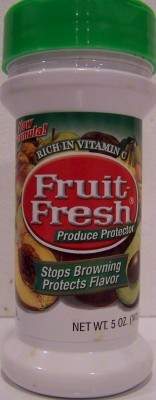 Now,
to keep the fruit from turning brown, when you get a bowlful, sprinkle
1/4 cup lemon juice or Fruit-Fresh (which is just a mix of citric acid
and vitamin C, perfectly natural). Then stir the quince to make
sure all the surfaces have been coated.
Now,
to keep the fruit from turning brown, when you get a bowlful, sprinkle
1/4 cup lemon juice or Fruit-Fresh (which is just a mix of citric acid
and vitamin C, perfectly natural). Then stir the quince to make
sure all the surfaces have been coated.
Here's a tip from another visitor. I haven't tried it yet, but it's worth a try, if you are having problems with quince turning pink:
"I just canned them last week and the water bath produced nice white quince, but the pressure canner turned them pink. I had never seen that before, glad to see from your instructions that the quince are ok. Suggestion for keeping quince from turning brown from an old Farm Journal Freezing and Canning cookbook: After peeling, coring, etc. the quince, drop them in a solution of 2 tblsp. each of salt and vinegar to 1 gal. water. Drain before packing jars or putting into syrup for hot pack. Used this method many times and always produced nice quince. Thanks again for the information. "
Step 8 - For a Hot Pack
 Hot
packing is recommended for all fruits because it is a bit safer and
makes fruit easier to pack in jars. Raw packs also make poor quality
quince. Hot packed quince are less likely to float than quince
canned by the raw-pack method. Just put the cut quince into the boiling
syrup solution for 5 minutes. (If you want to use the "cold pack" or
"raw pack" method, just skip this step!)
Hot
packing is recommended for all fruits because it is a bit safer and
makes fruit easier to pack in jars. Raw packs also make poor quality
quince. Hot packed quince are less likely to float than quince
canned by the raw-pack method. Just put the cut quince into the boiling
syrup solution for 5 minutes. (If you want to use the "cold pack" or
"raw pack" method, just skip this step!)
Step 9 - Fill the jars
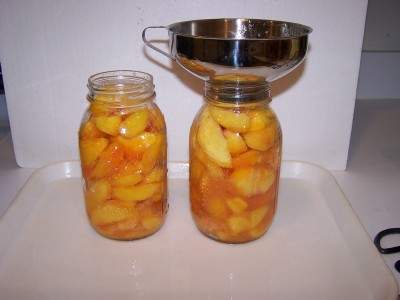 Pack
the quince into sanitized jars (leaving 1/2 inch space at the top) and
cover with boiling sugar syrup leaving 1/2 inch head space. (If you don't
cook or heat the quince first, this is called "cold packing"). Run a
rubber spatula or table knife gently between quince and jar to release
trapped air bubbles. To do this more effectively, tilt the jar slightly
while running the tool between the fruit and the edge of the jar and also
pressing inward against the fruit a few times.
Pack
the quince into sanitized jars (leaving 1/2 inch space at the top) and
cover with boiling sugar syrup leaving 1/2 inch head space. (If you don't
cook or heat the quince first, this is called "cold packing"). Run a
rubber spatula or table knife gently between quince and jar to release
trapped air bubbles. To do this more effectively, tilt the jar slightly
while running the tool between the fruit and the edge of the jar and also
pressing inward against the fruit a few times.
After packing the quince in the jar, pour the sugar solution up to 1/2 inch (1 cm) from the top. the fruit should be covered completely. Wipe rim and screw threads with a clean damp cloth. Add lid, screw band and tighten firmly and evenly. Do not over tighten.
Tips!
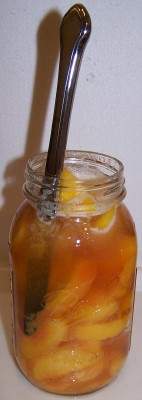 Canned
fruits often will float if the sugar syrup is too heavy, if jars are
packed too loosely or if air remains in the tissues of the fruit after
processing. To avoid this use a light or medium sugar syrup, make sure
fruit is firm and ripe and pack fruit tightly in jars without crushing.
Canned
fruits often will float if the sugar syrup is too heavy, if jars are
packed too loosely or if air remains in the tissues of the fruit after
processing. To avoid this use a light or medium sugar syrup, make sure
fruit is firm and ripe and pack fruit tightly in jars without crushing.
If fruit is not covered by liquid it may darken during storage (but does
not necessarily mean it is spoiled, as all fruits will darken somewhat).
To avoid this be sure fruit is covered by removing air bubbles from jars
liquid while still leaving the recommended head space. Also be sure to
remove trapped air bubbles as described earlier.
Quince, pears and apples may also show a blue, red or pink color change
after canning. This is the result of natural chemical changes that
sometimes occur as fruits are heated. It is harmless and won't affect
flavor!
Also, avoid storing canned food near heat sources such as a furnace,
water heater, hot water or sunny areas. Jars need to be kept cool and
dark for longer storage life and to protect against spoilage. Be sure to
store in a dry place. If the lid or band rusts, that can cause the seal
to break.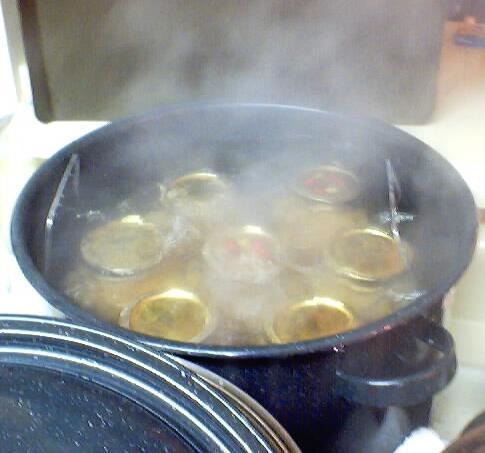
Step 11 - Process the jars in the water bath (or pressure canner)
You can "can" quince in either a water bath or pressure canner.
Water bath canner: Put the sealed jars in the canner and keep them cover with at least 1 inch of water and boiling. Boil them for at least 20 minutes (and no more than 30 min).
|
Water Bath Times.
Recommended process time for Quince, halved
or sliced in a boiling-water canner, using a hot pack in pints or
quart jars. |
||||
| Process Time at Altitudes of | ||||
| Jar size | 0 - 1,000 ft | 1,001 - 3,000 ft | 3,001 - 6,000 ft | Above 6,000 ft |
| pints |
20 min | 25 | 30 | 35 |
| quarts | 25 min | 30 | 35 | 40 |
Pressure Canning: Processing directions for canning quince in a dial, or a weighted-gauge canner are given in Table 1, Table 2, and Table 3.
|
Table 2.
Process Times for Quince, halved or sliced
in a Dial-Gauge Pressure Canner. |
||||||
| Canner Pressure (PSI) at Altitudes of | ||||||
| Style of Pack | Jar Size | Process Time | 0 - 2,000 ft | 2,001 - 4,000 ft | 4,001 - 6,000 ft | 6,001 - 8,000 ft |
| Hot | Pints or Quarts | 10 minutes | 6 psi | 7 psi | 8 psi | 9 psi |
|
Table 3.
Process Times for Halved or sliced Quince in
a Weighted-Gauge Pressure Canner. |
|||
| Canner Pressure (PSI) at Altitudes of | |||
| Jar Size | Process Time (Min) | 0 - 1,000 ft | Above 1,000 ft |
| Pints or Quarts | 10 | 5 | 10 |
Step 12 - Remove and cool
 Lift
the jars out of the water and let them cool without touching or bumping
them in a draft-free place (usually takes overnight), here they won't be
bumped. You can then remove the rings if you like, but if you leave them on, at least loosen them quite a bit, so they don't rust in place due to trapped moisture. Once the jars are cool,
you can check that they are sealed verifying that the lid has been sucked
down. Just press in the center, gently, with your finger. If it pops up
and down (often making a popping sound), it is not sealed. If you put the
jar in the refrigerator right away, you can still use it. Some people
replace the lid and reprocess the jar, then that's a bit iffy. If you heat
the contents back up, re-jar them (with a new lid) and the full time in
the canner, it's usually ok.
Lift
the jars out of the water and let them cool without touching or bumping
them in a draft-free place (usually takes overnight), here they won't be
bumped. You can then remove the rings if you like, but if you leave them on, at least loosen them quite a bit, so they don't rust in place due to trapped moisture. Once the jars are cool,
you can check that they are sealed verifying that the lid has been sucked
down. Just press in the center, gently, with your finger. If it pops up
and down (often making a popping sound), it is not sealed. If you put the
jar in the refrigerator right away, you can still use it. Some people
replace the lid and reprocess the jar, then that's a bit iffy. If you heat
the contents back up, re-jar them (with a new lid) and the full time in
the canner, it's usually ok.
Canned quince and quince nectar will maintain quality best when stored up to 66 months at 40/F, 40 months at 70/F, or 15 months at 90/F.
If you'd rather dry or freeze quince, let me know; I'm working on those directions. Dried quince can be stored up to 24 months at 40/F, 3 months at 70/F, or 1 month at 90/F. Well packaged frozen quince will keep up to 18 months.
Other Equipment:
From left to right:
- Jar lifting tongs
helpful to pick up hot jars
- Lid lifter
- to remove lids from the pot
of hot water - Lids
- disposable - you may only
use them once - Ring
- holds the lids on the jar until after
the jars cool - then you remove them, save them and reuse them - Canning Jar funnel
- to fill the jars
Frequently asked questions!
|
McSunley 21.5 quart Water Bath Canner, Stainless Steel See here for related tools, equipment, supplies on Amazon 
|
Home Canning KitsSee the seller's website for features, pricing and user reviews! This is the same type of standard canner that my grandmother used
to make everything from pears to jams and jellies to tomato and spaghetti
sauce. This complete kit includes everything you need: the canner, jar
rack, Jar grabber tongs, lid lifting wand, a plastic funnel, labels,
bubble freer, and the bible of canning, the Ball Blue Book. You will never
need anything else except more jars and lids!
|
| Find this item (B09WDKLMPW) on Amazon See here for related tools, equipment, supplies on Amazon |
Deluxe Food Strainer & Sauce MakerD220-DLXRetail,
usually around $89.95 Store 2: Click on the link below: See here for related tools, equipment, supplies on Amazon
|
Looking for canning equipment and supplies?
Water bath canner with a jar rack
Pressure canners for gas, electric and induction stoves: Presto 23Qt or T-fal 22Qt
Canning scoop (this one is PERFECT)
Ball Blue book (most recent version)
Jars: 8oz canning jars for jams
Find Other types of farms:
Farm markets and roadside stands
Road trips and camping resources
Local Honey, apiaries, beekeepers
Consumer fraud and scams information
Home canning supplies at the best prices on the internet!
Maple Syrup Farms, sugarworks, maple syrup festivals
Environmental information and resources
Farms For Your Event for birthday parties, weddings, receptions, business meetings, retreats, etc.
Festivals - local fruit and vegetable festivals
Get the
most recent version of
the Ball Blue Book
With this Presto 23 quart pressure canner and pressure cooker, you can "can" everything, fruits, vegetables, jams, jellies, salsa, applesauce, pickles, even meats, soups, stews. Model 01781

You can make jams, jellies, can fruit, applesauce, salsa and pickles with water bath canners, like this Granite Ware 12-Piece Canner Kit, Jar Rack, Blancher, Colander and 5 piece Canning Tool Set

